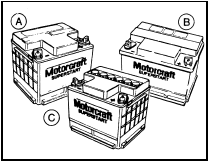General information and precautions
General information The engine electrical system includes all charging, starting and ignition system components and the engine oil pressure sensor. Because of their engine-related functions, these components are covered separately from the body electrical devices such as the lights, instruments, etc (which are covered in Chapter 12). Refer to Part B of this Chapter for information on the ignition system.
The electrical system is of the 12-volt negative earth type.
The battery is of the low maintenance or maintenance-free type and is charged by the alternator, which is belt-driven from a crankshaft-mounted pulley (see illustration).

1.3 Battery types
A Maintenance-free sealed cell type B Maintenance-free removable cell top type C Low maintenance type
The starter motor is of the pre-engaged type, incorporating an integral solenoid. On starting, the solenoid moves the drive pinion into engagement with the flywheel ring gear before the starter motor is energised. Once the engine has started, a one-way clutch prevents the motor armature being driven by the engine until the pinion disengages from the flywheel.
Further details of the various systems are given in the relevant Sections of this Chapter.
While some repair procedures are given, the usual course of action is to renew the component concerned. The owner whose interest extends beyond mere component renewal should obtain a copy of the “Automobile Electrical & Electronic Systems Manual”, available from the publishers of this manual.
Precautions
It is necessary to take extra care when
working on the electrical system to avoid
damage to semi-conductor devices (diodes
and transistors), and to avoid the risk of
personal injury. In addition to the precautions
given in “Safety First!” at the beginning of this
manual, observe the following items when
working on the system.
Always remove rings watches, etc before working on the electrical system. Even with the battery disconnected, capacitive discharge could occur if a component live terminal is earthed through a metal object.
This could cause a shock or nasty burn.
Do not reverse the battery connections.
Components such as the alternator, or any other having semi-conductor, could be irreparably damaged.
If the engine is being started using jump leads and a slave battery, connect the batteries positive to positive and negative to negative. This also applies when connecting a battery charger.
Never disconnect the battery terminals, or alternator multi-plug connector, when the engine is running.
The battery leads and alternator multi-plug must be disconnected before carrying out any electric welding on the car.
Never use an ohmmeter of the type incorporating a hand cranked generator for circuit or continuity testing.
See also:
Tie-rod end - removal and refitting
Note: A balljoint separator tool will be
required for this operation.
Removal
1 Loosen the relevant front roadwheel nuts,
apply the handbrake, jack up the front of the
vehicle and support on axle ...
Engine mountings - renewal
1 The engine mountings incorporate
hydraulic dampers and must be renewed if
excessive engine movement is evident.
2 Working in the engine compartment,
unscrew the central nuts securing the engine
...
Fuel and exhaust systems - fuel injection
General information and precautions
General information
2.0 litre SOHC models
The fuel injection system fitted to these
models is of the Bosch L-Jetronic type. The
system is under the overall con ...
